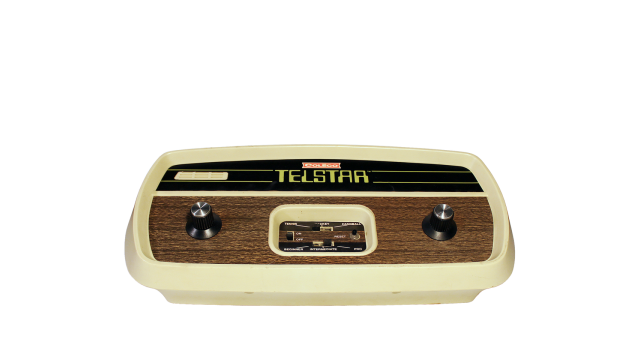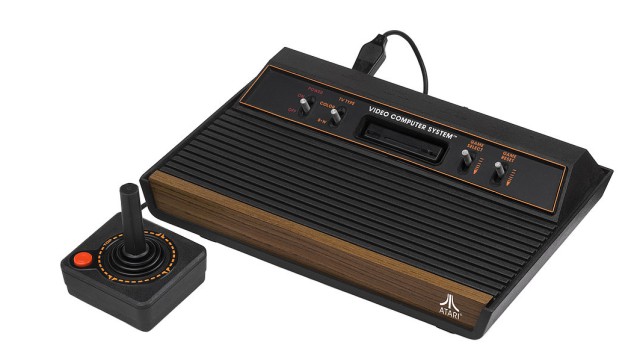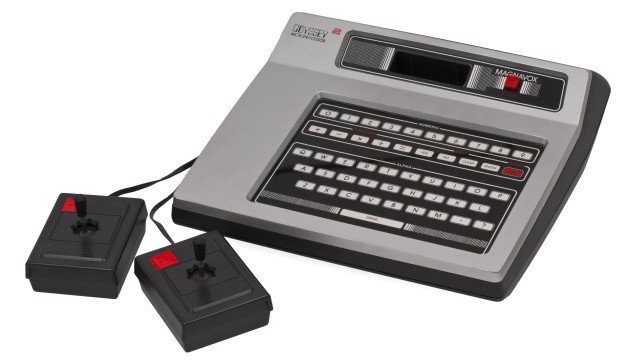
Intellivision
Launches: 1979
Discontinued: 1990
Life span: 11 years
Units sold: 4 000 000
Generation: 2nd
 Intellivision technical specifications
Intellivision technical specifications
CPU: GI CP1610 (16 bits)
Memory: 1 KB
 Intellivision video specifications
Intellivision video specifications
Intellivision graphics capabilities.
 Intellivision audio specifications
Intellivision audio specifications
Intellivision sound capabilities.
Audio chip:
Audio mode:
 Controllers of Intellivision
Controllers of Intellivision
 Intellivision games support
Intellivision games support
Support: Cartridge
Intellivision games
Games library: 133
Intellivision story
The first Intellivision home video game console was released by Mattel Electronics in 1979 to compete with the Atari 2600. The console platform sold an estimated 5 million units and kicked off the first “console war” with a head-to-head advertising campaign that featured sports journalist and actor George Plimpton in a series of ads comparing the two systems.
The beginning
The Mattel Intellivision was a pioneering video game console that emerged in the late 1970s and early 1980s, during a time when the home video game market was still in its infancy. The story of the Intellivision’s creation, development, launch, and market reception is a fascinating chapter in the history of video gaming, reflecting the ambitions of Mattel, the challenges of early console development, and the evolving landscape of the industry.
The creation of the Intellivision can be traced back to the late 1970s when Mattel, a major player in the toy industry, was looking to expand into the emerging market of electronic entertainment. The success of Atari's Video Computer System (later known as the Atari 2600) had demonstrated the potential of home video game consoles, and Mattel saw an opportunity to leverage its brand and resources to create a competing product. The company wanted to produce a console that would not only rival the Atari 2600 but also surpass it in terms of technological capabilities and gaming experience. Mattel's executives envisioned a system that would appeal to a broad audience, including both children and adults, and they were determined to create a product that could establish Mattel as a serious contender in the growing video game industry.
To realize this vision, Mattel established a new division called Mattel Electronics in 1978, tasked with developing and marketing electronic games. The division was staffed with a team of engineers and designers who began working on what would become the Intellivision. From the outset, the goal was to create a console that would offer superior graphics and sound compared to the Atari 2600, which, despite its popularity, was already showing signs of age with its relatively simple, blocky graphics and limited sound capabilities.
The development of the Intellivision was marked by several key technological innovations. At the heart of the system was the GI CP1610 microprocessor, a powerful chip for its time that allowed the Intellivision to produce more detailed and complex graphics than the Atari 2600. The system was also equipped with a 16-color palette, which was a significant improvement over the limited color options available on earlier consoles. This enabled the Intellivision to display richer, more vibrant visuals, with sprites and backgrounds that were more defined and lifelike.
Another significant aspect of the Intellivision’s development was its innovative sound capabilities. Unlike the Atari 2600, which had relatively basic sound effects, the Intellivision featured a dedicated sound chip capable of producing multi-channel audio, allowing for more complex and varied sound effects and music. This enhanced audio experience was intended to make games more immersive and engaging for players.
One of the most distinctive features of the Intellivision was its controller design. The console's controllers were unlike anything else on the market at the time, featuring a unique disc-based directional pad instead of the traditional joystick. This disc could detect 16 directions of movement, offering more precise control than the 8-direction joysticks used by other consoles. The controllers also included a numeric keypad with 12 buttons, which could be used in conjunction with plastic overlays that came with each game. These overlays provided context-sensitive functions for the buttons, allowing for more complex and varied gameplay mechanics. The controllers even had side buttons (referred to as "action buttons") that could be used for various in-game actions, making the Intellivision one of the first consoles to offer a more sophisticated control scheme.
In addition to its hardware innovations, Mattel also placed a strong emphasis on the quality of its software. The company knew that to compete with Atari, it would need to offer a compelling lineup of games that could showcase the Intellivision's capabilities. To this end, Mattel invested in developing a series of high-quality, original games, as well as securing licenses for popular brands and sports franchises. The company established a dedicated team of game developers, known internally as the Blue Sky Rangers, who were responsible for creating many of the Intellivision's most iconic titles. These games were designed to take full advantage of the system's advanced graphics and sound capabilities, offering gameplay experiences that were more complex and engaging than those available on other consoles.
The launch of the Intellivision was a carefully planned event, aimed at positioning the console as a superior alternative to the Atari 2600. Mattel began test-marketing the Intellivision in select regions in 1979, with a full nationwide release following in 1980. The console was priced at $299, which was relatively expensive at the time, reflecting its advanced technology and the premium gaming experience it promised to deliver. Alongside the console, Mattel launched with a selection of games that highlighted its strengths, including sports titles like Major League Baseball and NFL Football, which were some of the first video games to be officially licensed by professional sports leagues.
Mattel's marketing strategy for the Intellivision was aggressive and focused heavily on the system's technical superiority. The company produced a series of television commercials that directly compared the Intellivision's graphics and sound to those of the Atari 2600, often using side-by-side footage to highlight the differences. These commercials featured actor George Plimpton as a spokesperson, who presented the Intellivision as the more sophisticated and capable choice for discerning gamers. The "Intelligent Television" branding emphasized the console's advanced technology and its appeal to an audience that sought more than just simple arcade-style games.
The market reception of the Intellivision was initially very positive. Consumers and critics alike were impressed by the console's advanced graphics and sound, as well as its innovative controller design. The Intellivision was widely regarded as the first true competitor to the Atari 2600, and it quickly gained a significant share of the home video game market. By 1982, the Intellivision had sold over one million units, making it one of the best-selling consoles of its time.
The success of the Intellivision was also driven by its strong library of games. The console became known for its sports titles, which were particularly popular with gamers who appreciated the more realistic and strategic gameplay they offered compared to the simpler arcade-style games on the Atari 2600. Titles like NBA Basketball, NHL Hockey, and PGA Golf were well-received and helped to establish the Intellivision as the go-to console for sports gaming.
In addition to sports games, the Intellivision featured a diverse range of other titles, including action games, strategy games, and even educational software. Mattel also expanded the system's capabilities with various peripherals and accessories, such as the Intellivoice module, which added voice synthesis to certain games, and the Entertainment Computer System (ECS), which turned the console into a more fully-fledged computer with a keyboard and additional memory. These add-ons were part of Mattel's broader strategy to position the Intellivision as a versatile entertainment system that could appeal to a wide range of consumers.
Despite its early success, the Intellivision faced increasing competition as the video game market became more crowded. In 1982, Atari released the Atari 5200, a more advanced console that was designed to compete directly with the Intellivision. At the same time, Coleco introduced the ColecoVision, which also offered superior graphics and sound compared to the Atari 2600 and quickly became a popular choice among gamers. The arrival of these new consoles put pressure on Mattel to continue innovating and expanding the Intellivision's game library.
However, the video game industry was heading toward a significant downturn. The market became oversaturated with consoles and low-quality games, leading to a loss of consumer confidence and a sharp decline in sales across the industry. This period, known as the video game crash of 1983, had a devastating impact on all major console manufacturers, including Mattel. The Intellivision, despite its earlier success, was not immune to these challenges. Sales of the console and its games began to decline rapidly, and Mattel found itself struggling to maintain its position in the market.
In response to the worsening situation, Mattel made several attempts to revive the Intellivision's fortunes. The company introduced a redesigned version of the console, known as the Intellivision II, which was smaller and cheaper to produce. Mattel also continued to release new games and peripherals in an effort to keep the system relevant. However, these efforts were ultimately unsuccessful in reversing the downward trend.
By 1984, Mattel decided to exit the video game business altogether. The company sold the rights to the Intellivision to a group of investors who formed a new company called Intellivision, Inc. This new entity continued to support the console for a few more years, releasing new games and even developing a third version of the hardware, but the momentum was gone. The Intellivision gradually faded from the market, overshadowed by the more advanced consoles that would emerge in the mid-1980s.
In the years since its discontinuation, the Intellivision has been recognized as a significant milestone in the history of video gaming. It was one of the first consoles to offer a truly next-generation experience, with advanced graphics, sound, and gameplay that set it apart from its competitors. The Intellivision also introduced several innovations that would influence the design of future consoles, including its unique controller design and the concept of expanding a console's capabilities through peripherals and add-ons.
Today, the Intellivision is remembered fondly by retro gaming enthusiasts and collectors, who appreciate its pioneering spirit and the role it played in the early development of the video game industry. While it may not have had the same long-term impact as some of its competitors, the Intellivision remains an important part of gaming history, a testament to the creativity and ambition of the team at Mattel Electronics who sought to create something truly special in the world of electronic entertainment.
Next Mattel console: HyperScan



